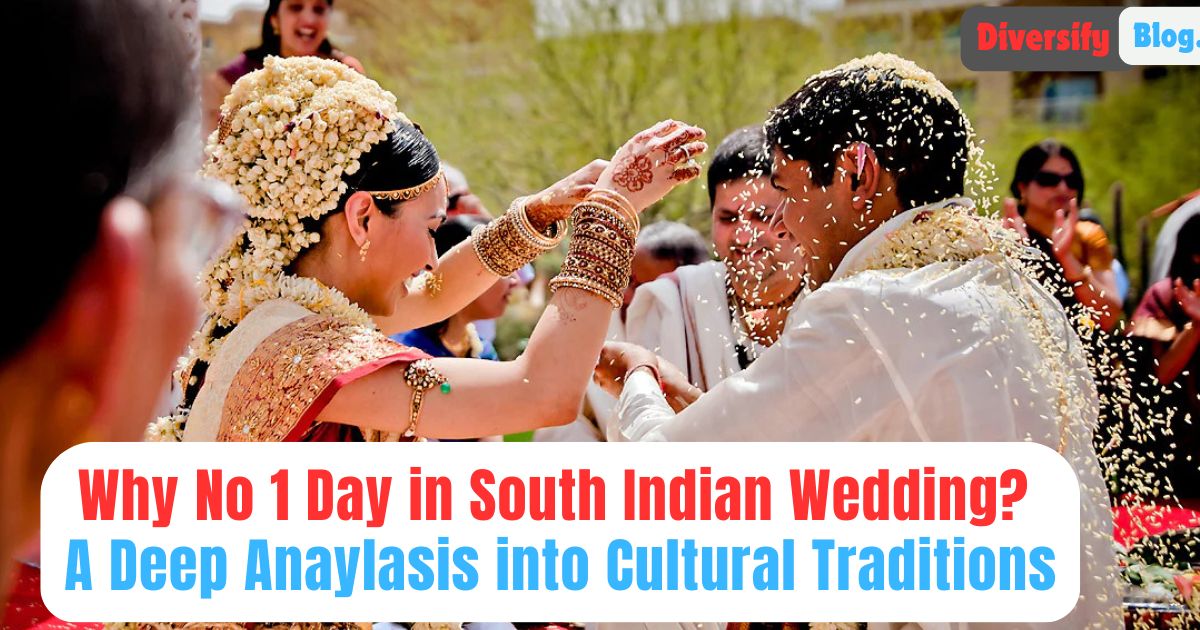South Indian weddings are renowned for their grandeur and deep-rooted cultural significance, spanning multiple days and involving intricate rituals. In contrast to Western-style weddings, which are often completed in a day, a South Indian wedding stretches out to give every tradition the attention it deserves.
This leads to the essential question: Why No 1 day in South Indian wedding? The reason lies in the vast cultural, religious, and emotional significance that each ceremony holds, requiring ample time to be performed properly.
Table of Contents
The notion of a one-day celebration simply doesn’t align with the South Indian belief in honoring each step of the wedding process. Why no 1 day in South Indian wedding? The answer is simple – it would be impossible to fit all the essential pre-wedding, main wedding, and post-wedding rituals into a single day without losing their profound meaning.
The Importance of a Multi-Day Wedding Celebration
South Indian weddings generally extend over 2 to 5 days, depending on the customs of the particular community and family traditions. Each day has its own unique set of rituals that are not only important religiously but also emotionally, marking different milestones in the journey of marriage. This time allocation helps families connect and ensures that all traditional aspects are performed with the respect they deserve.
Day One: The Bride’s Ceremony
The first day typically revolves around the bride’s family, setting the stage for the grand celebrations ahead. Rituals like the Haldi ceremony and Mehendi ceremony are key elements. In the Haldi ceremony, turmeric paste is applied to the bride’s skin, symbolizing purity and blessing her with glowing skin for her big day.
Similarly, the Mehendi ceremony involves intricate henna designs on her hands and feet, which is believed to bring good luck. These sacred pre-wedding ceremonies serve as preparation for the main event, and they play a big role in explaining why no 1 day in South Indian wedding can cover all of these essential traditions.
Pre-Wedding Rituals: A Sacred Beginning (1 Day in South Indian Wedding)
One of the most significant reasons behind why no 1 day in South Indian wedding can suffice is the detailed series of pre-wedding rituals that both families must observe. These traditions serve as more than just formalities; they are the foundation of a blessed and harmonious union.
1. Engagement Ceremony
The engagement ceremony, often the first pre-wedding event, is when the families come together to formally announce the upcoming union. Rings, gifts, and blessings are exchanged, signifying the beginning of the marriage journey.
2. Haldi and Mehendi
The Haldi ceremony, as mentioned earlier, is not just about beautifying the bride and groom but also about warding off evil spirits and bringing good fortune. The Mehendi ceremony is equally important and symbolizes love and prosperity.
3. The Arrival of the Groom
Traditionally, the groom’s arrival on the day before the wedding marks a festive occasion filled with wedding music, dance, and joy. The groom’s procession, often referred to as the Baraat, is a grand celebration where his family members arrive at the bride’s place to formally begin the wedding rituals.
These pre-wedding ceremonies take time to unfold and explain why condensing the entire process into a single day would not be sufficient to maintain their significance.
The Wedding Day: Morning Hours Are Considered Auspicious

The main wedding day, often conducted in the early morning hours, holds immense importance in South Indian culture. Morning hours are considered auspicious, and the exact timing of the wedding ceremony is meticulously chosen by astrologers to align with favorable planetary positions. The wedding rituals start early because it’s believed that the wedding happens in morning to invoke blessings from deities when the energy is most positive.
The core rituals include the tying of the Mangalsutra (a sacred thread tied around the bride’s neck by the groom, signifying their union), the exchange of garlands, and the Saptapadi ritual (the bride and groom take seven sacred steps together).
These moments are not just symbolic; they are the very heart of the wedding. Trying to rush through them or fitting all of these ceremonies into a single day would reduce the richness and significance of the event. That’s another key reason why no 1 day in South Indian wedding could ever capture its full essence.
Post-Wedding Rituals and Celebrations
Even after the wedding vows have been exchanged, the celebrations are far from over. South Indian weddings include a variety of post-wedding ceremonies that solidify the union between the bride and groom’s families.
1. Griha Pravesh (Welcoming the Bride)
One of the most heartwarming post-wedding rituals is the Griha Pravesh, where the bride is welcomed into her new home by her in-laws. This tradition marks her formal entry into her husband’s family, symbolizing the beginning of a new chapter in her life.
2. Reception
Following the wedding ceremony, a reception is hosted where family members, friends, and guests gather to celebrate the union. This is often a grand affair, featuring music, dancing, and a lavish feast.
The continuation of rituals and celebrations even after the main wedding day further strengthens the argument why no 1 day in South Indian wedding is possible. Each phase is essential to the overall experience and cannot be rushed.
Religious and Cultural Importance
The significance of South Indian weddings goes beyond the rituals and extends into the realm of religion and spirituality. Each tradition is carefully designed to seek blessings from the gods and ensure the couple’s prosperous future. Prayers and homas (fire rituals) are conducted during the wedding to invoke divine energies and protect the couple’s new life together.
In addition to religious customs, South Indian weddings are a time for bonding between families. The multi-day celebration allows for interactions between the bride’s and groom’s relatives, fostering strong family ties that would be impossible to cultivate in a one-day event. This element of community and togetherness is a huge factor in why no 1 day in South Indian wedding would be sufficient.
Conclusion: Why No 1 Day in South Indian Wedding?
To conclude, the question of why no 1 day in South Indian wedding can be answered by looking at the cultural, religious, and social depth of these ceremonies. Each day in the multi-day wedding celebration carries its own importance, from the pre-wedding functions to the post-wedding rituals.
Compressing all these beautiful traditions into a single day would take away the soul of the wedding, robbing it of its richness, emotion, and grandeur. South Indian weddings are about more than just the union of two people; they are about the union of two families, two communities, and the blessings of the divine. It’s this layered complexity that makes these weddings so special and why they can never be confined to just one day.
FAQs:
Why do South Indians marry during the day?
South Indian weddings are held during the day because mornings are considered spiritually pure and astrologically favorable. Traditional beliefs align with performing rituals in natural daylight, which symbolizes positivity and clarity.
How long is a South Indian wedding?
A South Indian wedding typically lasts 2 to 3 days. It includes pre-wedding ceremonies like the turmeric ritual (Haldi), the main wedding day, and post-wedding events like receptions and Grihapravesh (welcoming the bride).
What happens at a South Indian wedding?
Key rituals include the Kashi Yatra (where the groom is symbolically persuaded to marry), the Oonjal (swing ceremony), the tying of the mangalsutra, Saptapadi (the couple takes seven steps around the fire), and welcoming the bride into the groom’s home.
What is the most popular day for a wedding?
The most popular wedding day is based on astrology. Mondays, Wednesdays, Thursdays, and Fridays are common choices, while some days like Saturdays or inauspicious lunar days are avoided.


















